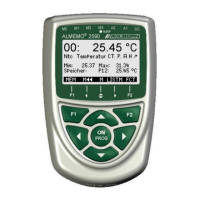
Do you have a question about the Ahlborn ALMEMO 2590-2A and is the answer not in the manual?
| Type | Data Logger |
|---|---|
| Input Channels | 2 |
| ALMEMO® Connector | Yes |
| Current Range | 0 to 20 mA |
| Input Types | Voltage, Current, Resistance, Temperature, Frequency |
| Voltage Range | -10 V to +10 V |
| Temperature Range | -200 °C to +1000 °C |
| Accuracy | ±0.1 % of reading ±1 digit |
| Sampling Rate | 10 Hz |
| Display | LCD |
| Communication Interfaces | RS-232, USB |
| Power Supply | Battery or AC adapter |
| Storage Temperature | -20 °C to +70 °C |
Details about measuring inputs for ALMEMO® sensors.
Lists available output sockets like V24, USB, Ethernet, etc.
Explanation of the device's operating keys and their functions.
Details of the product's guarantee and warranty conditions.
Lists the items included in the product package.
Specific considerations for using the device in different environments.
Guidelines for safe battery insertion, charging, and disposal.
Overview of the device's capabilities and features.
How sensor channels are programmed automatically by connectors.
Details on evaluating sensors and function channels.
Steps for connecting sensors to the device sockets.
Options for powering the device, including battery and mains adapter.
Information on battery life, monitoring, and low battery indication.
How to power the device using a mains adapter.
Details on using external DC power sources.
Connecting standard and custom sensors using ALMEMO® connectors.
How measuring channels are allocated and additional channels are used.
Importance of potential separation in measuring setups for safety.
Description of the LCD display and navigation through menus.
How measured values and status symbols are shown on the display.
Explanation of how function keys operate in different menus.
How to activate or program functions during operation.
Accessing the sensor display menu.
Accessing the general function menus.
Accessing the sensor programming menus.
Accessing device configuration settings.
The default menu showing measuring point, value, and units.
Performing zero-point correction and gain adjustment.
Function to zero the measured value as a reference.
How temperature affects measurements and compensation methods.
Automatic compensation for thermocouples using NTC sensor.
Calculating the difference between connected sensors.
Overview of all measuring points with their values and functions.
Lists available functions and their display/key commands.
Steps for configuring user menus using ALMEMO®-Control software.
Storing and displaying max, min, and individual measured values.
Overview of different averaging modes available.
Smoothing unstable or fluctuating measured values.
Calculating averages from manual measurement scans.
Calculating average values at cyclic intervals.
Averaging values from multiple associated measuring points.
Calculating volume flow by multiplying velocity and cross-section.
Calculating average velocity in flow channels via array measuring.
Acquiring and recording measured values to internal or external memory.
Details on the internal EEPROM memory for data logging.
Using an external SD-card for increased data logging capacity.
Programming and displaying the device's date and time.
Performing cyclic recording and output of measured values.
Assigning numbers to identify measuring operations.
Managing memory capacity, outputting, and clearing data.
Selecting between Normal, Sleep, Monitor, and Fail-safe scanning modes.
Operating the device in an energy-saving sleep mode for long-term monitoring.
Defining print layout for data output (List, Columns, Table).
Setting the required input channel for sensor parameters.
Assigning a 10-character alphanumeric designation to each measuring point.
Defining various averaging modes for data processing.
Protecting sensor programming with locking levels.
Scaling sensor signals and setting decimal point position.
Correcting sensor readings using zero-point and gain values.
Replacing default units with custom two-character units.
Using ranges for processing parameters or calculated results.
Setting special ranges, linearization, and multi-point calibration.
Accessing sensor parameters for routine or special applications.
Configuring relay assignments for alarm reporting.
Scaling analog output to a specific subrange displayed on screen.
Monitoring and setting minimum sensor supply voltage to prevent errors.
Setting a measuring point as a reference channel for calculations.
Using a second reference channel or multiplexer for input assignments.
Activating element flags for sensor-specific functions.
Entering text for print headers and network assignment.
Selecting the user interface language (German, English, French).
Adjusting display brightness and contrast levels.
Configuring interface settings, device address, and network communication.
Setting parameters for sensor compensation.
Setting hysteresis for alarm triggers.
Configuring general operating parameters like noise suppression.
Details on ALMEMO® data cables and their connections.
Connecting and configuring relay-trigger modules for outputs.
Configuring trigger sources for controlling measurement sequences.
Connecting and configuring analog output modules.
Scaling analog output to the used measuring range.
Troubleshooting steps for non-responsive display or keys.
Steps to resolve incorrect measured value readings.
Troubleshooting data transmission problems via interface.
Resolving issues with network data transmission.
Specifications and technical details of the device.
Summary of device features, options, and accessories.